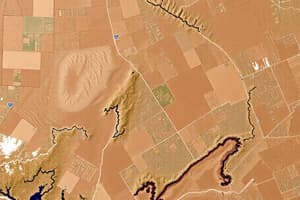Podcast
Questions and Answers
What is the main difference between dry snow and wet snow?
What is the main difference between dry snow and wet snow?
- Dry snow melts faster than wet snow.
- Dry snow contains only ice particles, while wet snow contains ice particles and free liquid water. (correct)
- Wet snow has a higher dielectric constant than dry snow.
- Wet snow has a lower density compared to dry snow.
What is the typical range of snow densities for fresh or new snow?
What is the typical range of snow densities for fresh or new snow?
- 100-150 kg/m3 (correct)
- 50-100 kg/m3
- 200-600 kg/m3
- 500-700 kg/m3
How does snow density change with the age of the snowpack?
How does snow density change with the age of the snowpack?
- Snow density decreases with the age of the snowpack due to increased air content.
- There is no change in snow density with the age of the snowpack.
- Snow density remains constant regardless of the age of the snowpack.
- Snow density increases with the age of the snowpack due to compaction and thermal metamorphism. (correct)
What does SWE stand for in the context of snow?
What does SWE stand for in the context of snow?
What is the range of the dielectric constant for snow?
What is the range of the dielectric constant for snow?
How are the thermal properties of snow important in relation to melting and runoff?
How are the thermal properties of snow important in relation to melting and runoff?
What happens to snow reflectance in the near-IR region as grain size (or age) increases?
What happens to snow reflectance in the near-IR region as grain size (or age) increases?
How does cloud cover impact the reflectance of snow?
How does cloud cover impact the reflectance of snow?
What impact does depth have on the visible wavelength reflectance of snow?
What impact does depth have on the visible wavelength reflectance of snow?
In which spectral range has potential been shown for snow/cloud discrimination?
In which spectral range has potential been shown for snow/cloud discrimination?
What happens to snow reflectance in the visible and near-infrared region compared to cloud reflectance?
What happens to snow reflectance in the visible and near-infrared region compared to cloud reflectance?
How does melting state affect the albedo of snow?
How does melting state affect the albedo of snow?
Why are NDSI values in shadow and non-shadow regions the same?
Why are NDSI values in shadow and non-shadow regions the same?
What is the purpose of using AVNIR-2 in satellite observations over glaciers?
What is the purpose of using AVNIR-2 in satellite observations over glaciers?
Why does the reflectance of dry snow not exceed 1% in the thermal infrared region for grain sizes above 100 mm?
Why does the reflectance of dry snow not exceed 1% in the thermal infrared region for grain sizes above 100 mm?
What range does the emissivity of dry snow typically fall within in the thermal infrared region?
What range does the emissivity of dry snow typically fall within in the thermal infrared region?
Why is a stepwise method required to estimate the emissivity of snow over a spectral region of interest?
Why is a stepwise method required to estimate the emissivity of snow over a spectral region of interest?
What does ε represent in the context of the text?
What does ε represent in the context of the text?
Why is the reflectance of snow in the SWIR band very low?
Why is the reflectance of snow in the SWIR band very low?
What characteristic of snow makes automated snow cover mapping difficult during winter?
What characteristic of snow makes automated snow cover mapping difficult during winter?
Why are water clouds and ice clouds more strongly reflecting than snow in the SWIR region?
Why are water clouds and ice clouds more strongly reflecting than snow in the SWIR region?
How can the problem of automated snow cover mapping in snow-covered regions be partially solved?
How can the problem of automated snow cover mapping in snow-covered regions be partially solved?
What advantage does utilizing middle infrared have for discriminating between snow and cloud?
What advantage does utilizing middle infrared have for discriminating between snow and cloud?
Why is NDSI useful for snow-cloud discrimination?
Why is NDSI useful for snow-cloud discrimination?




